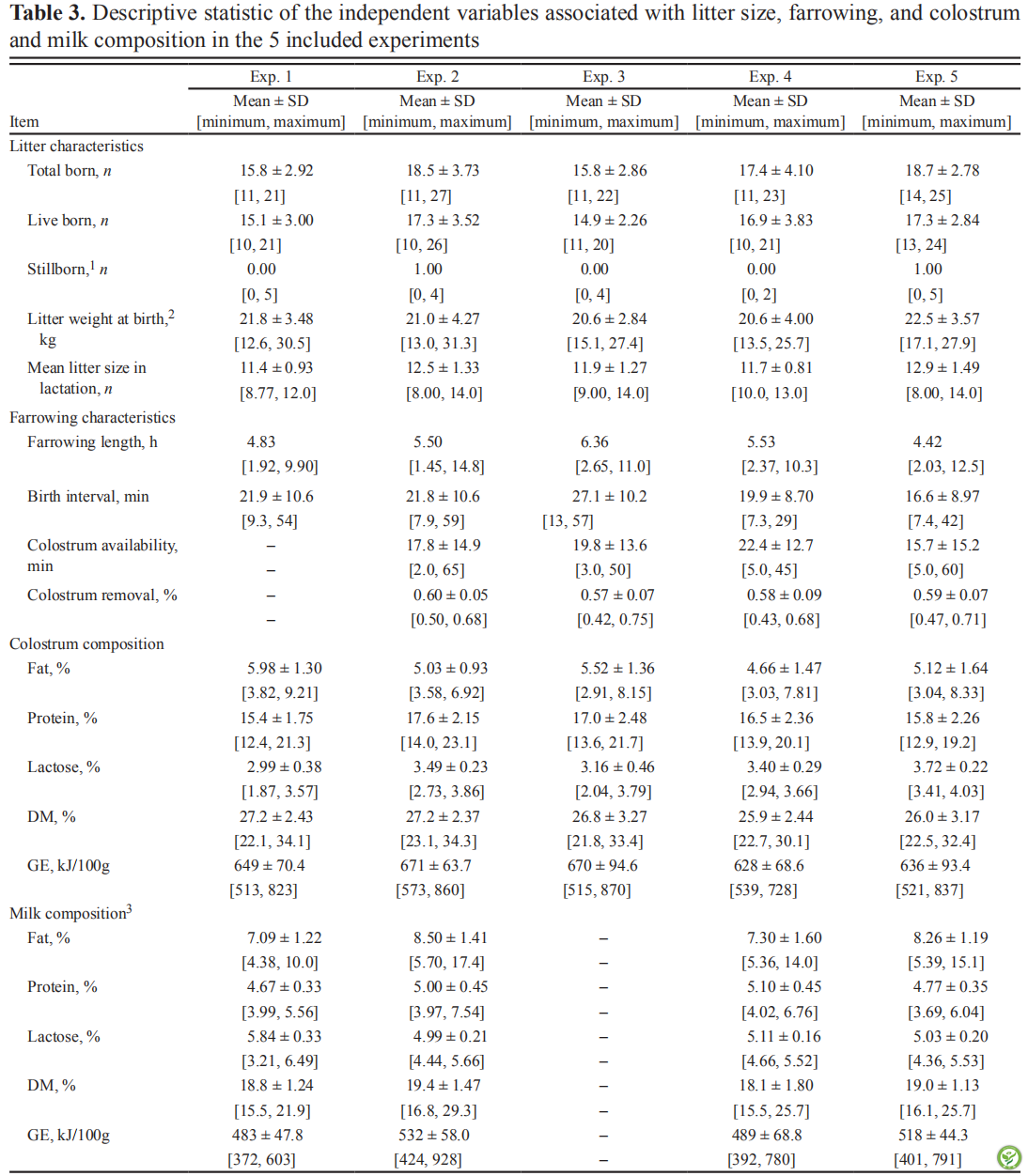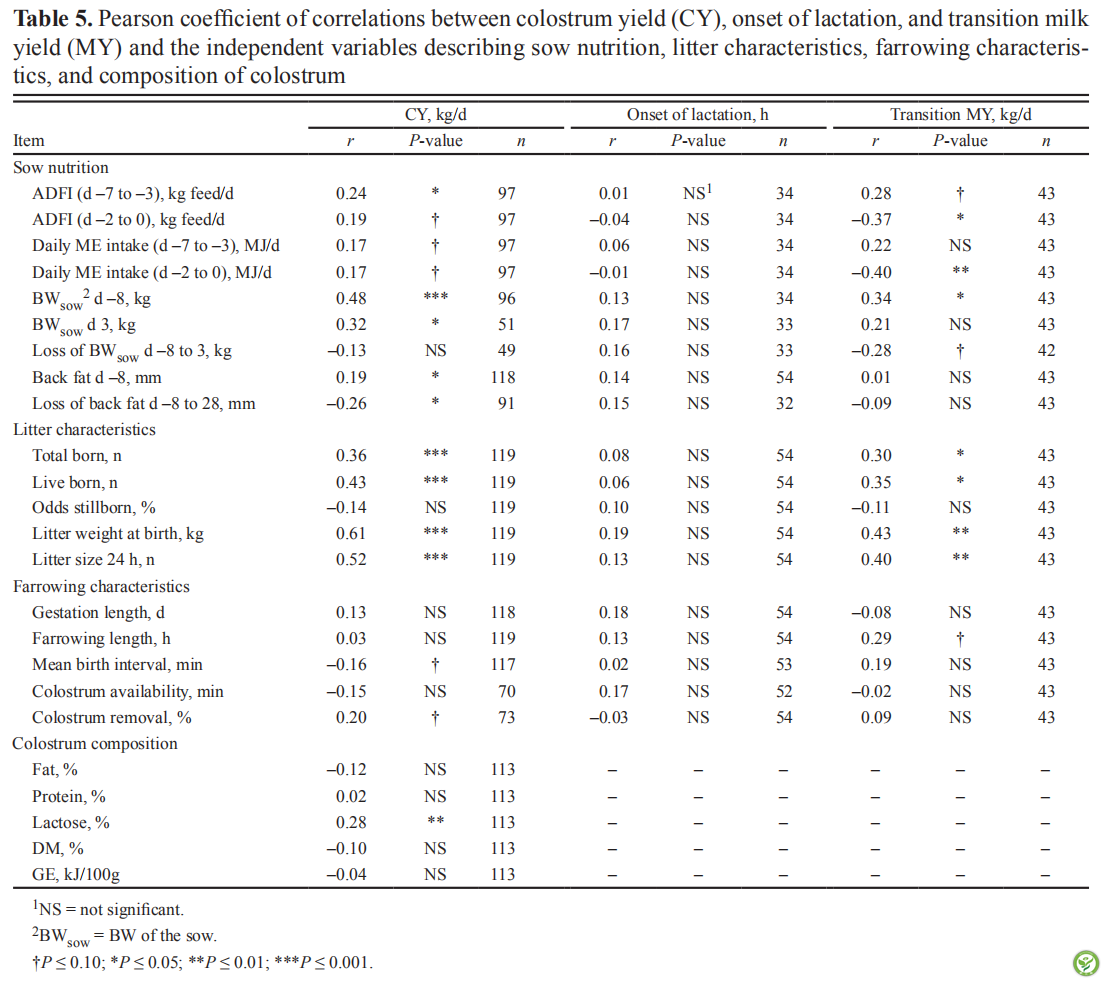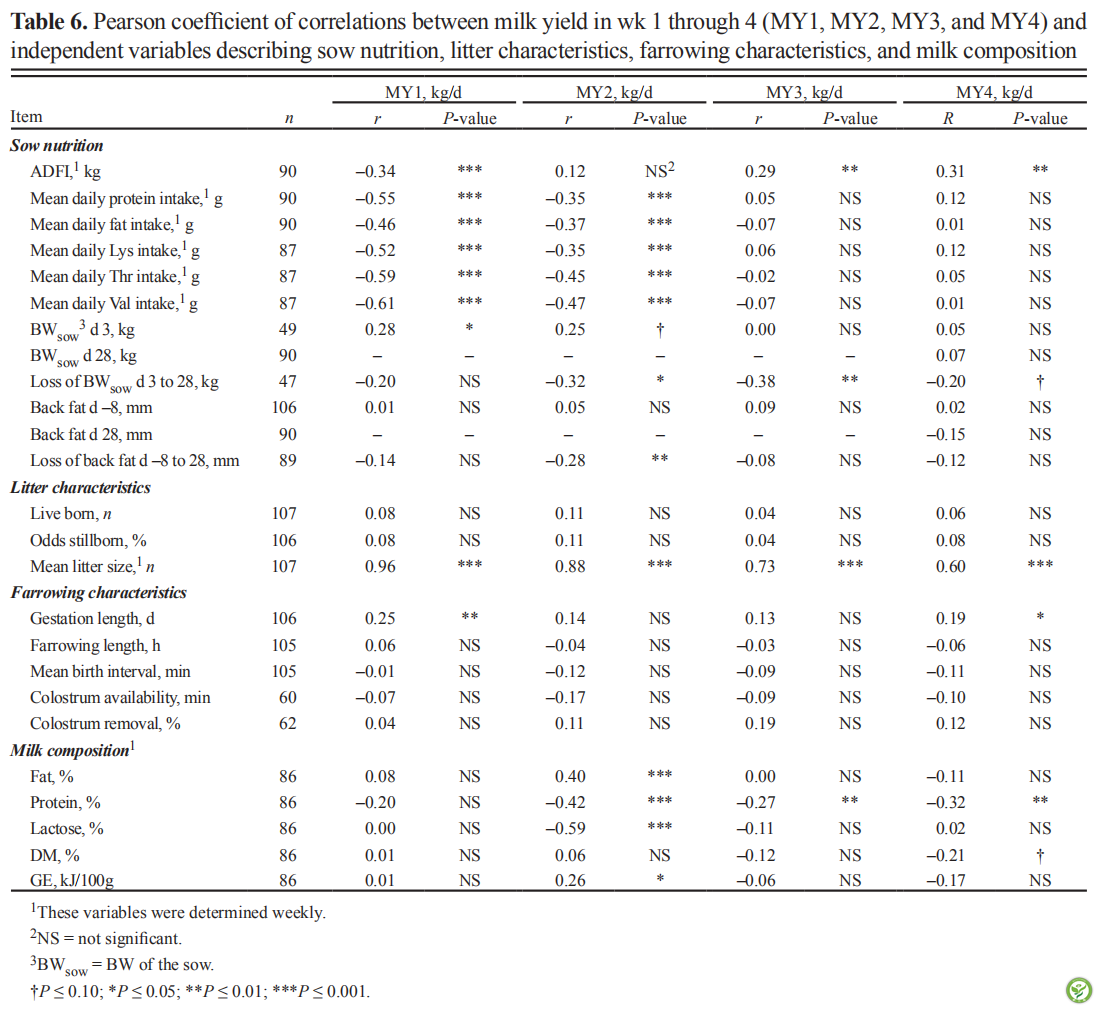Impact of sow and litter characteristics on colostrum yield, time for onset of lactation, and milk yield of sows
作者:C. N. Vadmand,*† U. Krogh,* C. F. Hansen,† and P. K. Theil*1
*Department of Animal Science, Aarhus University,
Research Center Foulum, DK-8830 Tjele, Danmark; †Department of Large Animal Science,
Faculty of Health and Medical Science, University of Copenhagen, DK-1870 Frederiksberg C, Denmark
来源:J. Anim. Sci. 2015.93:2488-2500 doi:10.2527/jas2014-8659
翻译:肠动力研究院 梁琦
【摘要】本文旨在评估母猪和窝产仔数对母猪生产力的影响。以初乳量(CY)、哺乳期开始的时间(乳汁分泌急剧上升的时间点,约产后31h)、过渡期泌乳量(MY;产后36-60h)、以及泌乳第1周-第4周的平均MY来定义母猪的生产力。因此,本文主要考察了营养物质、窝产仔数、分娩特征和奶水的组成等相关因素对母猪生产力的影响。实验数据来源于5个之前完成的实验,其中受试母猪121头,仔猪2044头。描述母猪生产力的变量都被定义为因变量,Pearson相关系数用于检验因变量之间的关系。结果显示,CY与泌乳期第1周和第2周的MY和过渡MY呈正相关(P <0.05),哺乳期的开始时间与过渡MY呈正相关(P <0.05),而与泌乳期的第1,2和4周的MY呈负相关(P <0.05)。试验还通过反向消除法对每个因变量进行了多元回归分析,以研究母猪营养、窝产仔数、分娩的特征和奶水成分(独立变量)的组成之间的关系。研究发现,在第1周-第4周,产仔数与CY和MY呈正相关(P <0.001)。4周内奶水的蛋白质浓度与MY呈负相关(P <0.01),这表明高泌乳特征的母猪在哺乳期间无法维持乳中蛋白质合成。此外,产前ME的平均摄入量(P <0.05)包括在过渡MY的回归模型中,并且产后第3天母猪的BW被包括在第一周的MY回归模型中(P <0.05)。除窝产仔数均匀外,未观察到独立变量与哺乳开始时间有相关性。总之,在未来如若最大化母猪生产力,关注初乳期和哺乳期启动期是有益的,应特别注意在日粮中添加蛋白质和必需氨基酸。
【关键词】乳腺分泌物,产奶量,泌乳开始时间,蛋白质,过渡乳
以下是本文的相关图表
表1:母猪生产力的描述性统计数据,包括初乳产量(CY),过渡乳量(MY)的开始时间和第1,2,3和4周的MY(MY1,MY2,MY3和MY4)

表2:在包含的5个实验中,与母猪营养相关的独立变量的描述性统计

表3:在5个包含的实验中,与产仔数,分娩以及初乳和奶水成分相关的独立变量的描述性统计

表4:描述母猪生产力的所有因变量之间的Pearson相关系数

表5:初乳量(CY),哺乳期开始和过渡乳量(MY)之间的Pearson相关系数以及描述母猪营养,产仔数,分娩特征和初乳组成的独立变量

表6:第1周-第4周(MY1,MY2,MY3和MY4)的产奶量与母猪营养,产仔数,分娩特征和奶水成分的独立变量之间的相关系数

表7:初乳量(CY)、过渡乳量(MY)、第1-4周的平均MY (MY1, MY2, MY3,MY4)采用逆向消元法及逐步回归确定回归模型

结论
总之,初乳期和哺乳期开始时的母猪生产力对泌乳期的MY产生了积极的影响。通过相关分析表明哺乳期的开始可能会影响泌乳曲线的形状,并且哺乳期的提前可能对哺乳过程中的MY有益。而产仔数被认为是初乳期,哺乳期甚至是整个泌乳期母猪生产力的决定因素。因此,喂养哺乳母猪时应始终考虑产仔数。此外,本研究表明,现代高产乳特征的母猪可能缺乏膳食蛋白质或必需AA,最终导致乳蛋白的合成受到影响。因此,应特别注意产仔数对MY的影响,因为MY极大地影响了蛋白质和AA的日常需求。此外,由于母猪生产力对哺乳期的整体影响,在初乳期和哺乳期开始时增加对母猪生产力的关注可能是有益的。
Abstract
The aim of the present study was to estimate the concurrent impact of sow and litter char- acteristics on sow productivity. Sow productivity was defined as colostrum yield (CY), onset of lactation (the time point when milk secretion increased steeply, approximately 31 h postpartum), transition milk yield (MY; 36-60 h postpartum), and the mean MY in wk 1 to 4 of lactation. Therefore, the study investigated how factors related with sow nutrition, litter characteristics, farrowing characteristics, and composition of mam- mary secreta affected sow productivity. Data obtained from 5 previous sow experiments were used. The vari- ables describing sow productivity were all defined as dependent variables and Pearson coefficient of corre- lation was used to examine relations among dependent variables. The results showed that CY was positively correlated with transition MY and MY in wk 1 and 2 of lactation (P < 0.05), and time for onset of lacta- tion was positively correlated with transition MY (P < 0.05) but negatively correlated with MY in wk 1, 2, and 4 of lactation (P < 0.05). Multivariate regression analyses with a backward elimination approach were performed for each dependent variable to investigate relations with characteristics of sow nutrition, litter size, farrowing, and composition of mammary secreta (independent variables). Litter size was positively related with both CY and MY in wk 1 to 4 (P < 0.001). Milk protein concentration was negatively correlated with MY in all 4 wk (P < 0.01), which indicated that high yielding sows were unable to maintain milk pro- tein synthesis during lactation. Additionally, mean intake of ME prepartum (P < 0.05) was included in the regression model for transition MY and the BW of the sow on d 3 was included in the regression model for MY in wk 1 (P < 0.05). Except litter equlization, none of the observed independent variables were related with time for onset of lactation. In conclusion, when maximizing sow productivity in the future, it may be rewarding to pay attention to sow productivity in the colostrum period and around time for onset of lacta- tion, and special attention should be given to dietary supplies of protein and essential AA.
Conclution
In conclusion, sow productivity in the colostrum period and at onset of lactation positively affected the MY during lactation. Through the correlation analysis it was suggested that onset of lactation might influence the shape of the lactation curve and that early onset of lactation could be beneficial for the MY during lacta-tion. Litter size turned out to be a determining factor for sow productivity in the colostrum period, at onset of lactation, and throughout lactation. Consequently, litter size should always be considered when feedinging sows. Furthermore, the present study suggested that modern highly prolific sows could be undersupplied with diety protein or essential AA and that the synthesis of milk protein in turn may be compromised. Special attention should, therefore, be given to the impact of lit-ter size on MY, because the MY greatly affects the daily requirements for protein and AA. Additionally, it might be rewarding to increase focus on the sow productivity in the colostrum period and at onset of lactation due to its positive influence on MY throughout lactation.
如您需原文,请联系本文作者和出版方,或请垂询肠动力研究院。本网站发布的所有资料将尽最大可能注明出处、作者及日期,如无意中侵犯了您的知识产权,请来信及时告知,我们将立即予以删除。
All information released by the WeChat Official Account will do its best to indicate the source, author and date. If we inadvertently infringe on your intellectual property, please inform us in time and we will delete it immediately.






